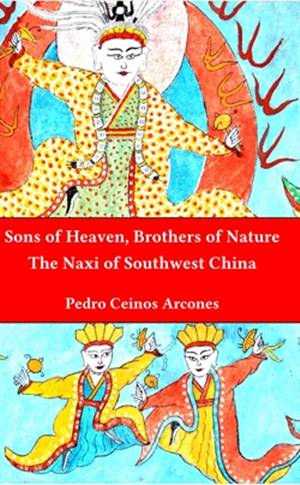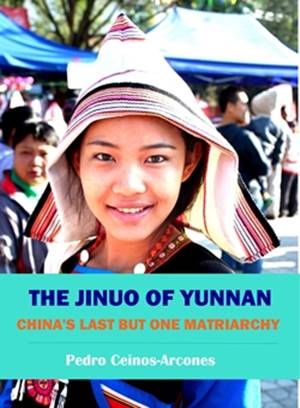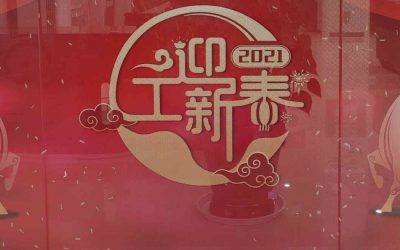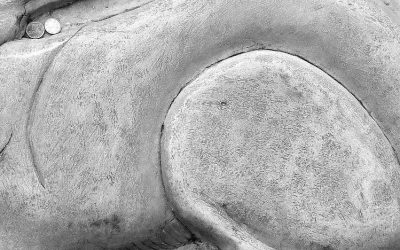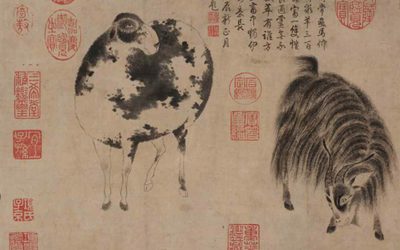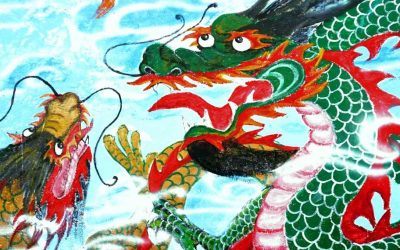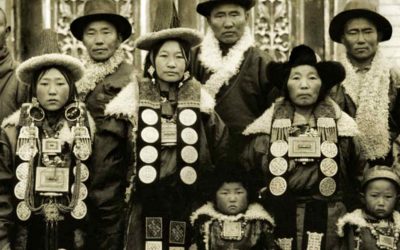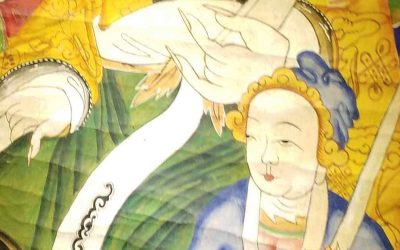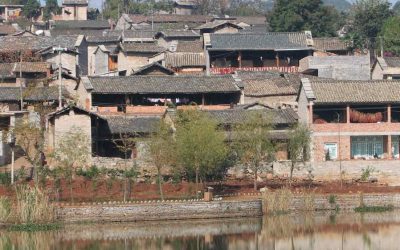On the left side was a densely wooded rocky hill. Its steep slope was carved into fantastic figures of unicorns, leogryphs and other mythological animals, and statues of gods and saints. They had been fashioned out of rock by the monks more than fifteen centuries ago. Under the hill were grottoes and caves filled with Buddhas and genii, where pilgrims were burning incense. Mantras in Sanskrit and archaic Chinese adorned the rocks, chiselled by the long departed hermits.]
Walking a little farther we came to the spacious entrance hall of a monastery which was unique in China in its grandeur, sanctity.
‘The Monastery of the Spirit’s Retreat’, softly exclaimed Chungan pointing to the three huge golden characters over the wide-open doors of the hall.
‘What a deep and secret meaning these words possess ! ‘ he continued. ‘It is a fitting name for this place, for it is difficult to conceive a better hermitage for the spirit of a man tired of the world and seeking concealment amidst the beautiful and tranquil.
Having emerged from this hall with its golden statue of Maitreya, the Lord Buddha of the Future, we stepped out into a large stone-flagged courtyard bounded by ancient trees. In front of them, on a high stone platform, flanked by two small pagodas and with a massive bronze incense burner in the middle, stood the main temple hall. its great height and immense size dwarfed all other buildings around it. The roof rose in three nobly curved tiers supported by colossal red wooden pillars.
The latticed gates of the hall were open as we came in. A mysterious semi-darkness, heavy with the odour of sandal-wood incense, pervaded the place. Right in the middle of the vast temple sat three golden Buddhas of such unbelievable majesty and of such gigantic proportions that when I saw them I was astonished. The images rested on lotus flowers which, in turn, were supported by stupendous stone pedestals. A colossal lantern, richly carved and decorated, with a perpetually-burning oil-lamp within, was suspended in front of the Trinity.
The central figure was that of the Lord Buddha himself with his royal coiffure and a sign of urna on his forehead. With the eyes turned inwards, gazing not at the world outside before him but at the world within himself; with his enigmatic smile, he sat there a true image of the man that he once was, but who had transcended all human emotions, desires, all suffering and mundane joy; who had found the lost path to Heaven and shown it to suffering mankind, and who at last had entered Nirvana and became himself a God. I gazed enchanted at the mystic statue. I felt mesmerized by the utter stillness of the temple. Clouds of incense floated in spirals towards the lofty ceiling and gently dissolved there in the golden rays of the sun coming through the narrow windows. The very silence was pregnant with the meaning of things unsaid, of prayers uttered and of petitions yet unoffered.
After we had finished our tour of the golden statues of arhats, lining the walls, and paused before an enormous image of the gentle Goddess Kwanyin, which stood against an altar piece representing the Western Paradise, we made our exit by a side door into a commodious guest hall where a young novice brought us cups of the monastery’s own tea. He smiled at Chungan and Tsungpoo, evidently recognizing them as frequent visitors. After a good rest we were ready to proceed to the next famous temple.
Goullart, Peter. Monastery of the Jade Mountain.
Peter Goullart. The monastery of Jade Mountain.
More posts on Chinese culture
All you need to know about the ox in the Chinese horoscope
All you need to know about the ox in the Chinese horoscope The ox is a very beloved animal among the Chinese, despite its size, it is tame and peaceful, often in the villages, it is the youngest children who take it to the field to play, it rarely acquires the fierce...
The snake in the Chinese horoscope
The snake in the Chinese horoscope The snake is an ambiguous animal in the collective image of the Chinese people. On the one hand, it is considered similar to the dragon. Many Chinese authors recognize that the dragon, nonexistent, is nothing more than the...
The Rabbit in the Chinese horoscope
The Rabbit in the Chinese horoscope The rabbit is a tender and adorable animal, which highlights its extraordinary fertility, perhaps that is why in the Chinese horoscope is the animal most closely related to the moon, the female star par excellence. This...
The goat in the Chinese horoscope
The Goat in the Chinese horoscope The goat and the sheep are confused in the symbolism of Chinese culture, as both are written with the Yang character 羊, specifying that the sheep gives wool (绵羊) and the goat lives in the mountain (山羊), in general, both have an...
The Pig in the Chinese horoscope
The Pig in the Chinese horoscope The pig in Chinese culture is an ambiguous character. It is seen as fat and ugly, feeding on the dirtiest things, but at the same time, its meat is the most appetizing for the Chinese. His meat is "meat" in general, as an archetype of...
The Dragon in the Chinese Horoscope
The Dragon in the Chinese Horoscope The dragon is the only animal in the Chinese horoscope that has only an imaginary existence, and in fact, in the horoscope of other indigenous peoples of China, it is replaced by another animal. Although the dragon is an imaginary...
More posts on China ethnic groups
The Flood Myth, Shamans and the Sani Religion
The Flood Myth, Shamans and the Sani Religion We continue with the second chapter of Paul Vial “Los Lolos”, in which fragments dedicated to the myth of the flood and the activities of its shamans are particularly striking. CHAPTER II - RELIGIOUS TRADITIONS These...
There was a matriarchy among the Yugur?
There was a matriarchy among the Yugur? The matrimonial customs of the Yugur present differences between their two main groups. Among the Eastern Yugur, girls had a time of great sexual freedom. Their rite of passage was the ceremony of making the headdress, which was...
The Yugur of Gansu, descendants of the Kings of Dunhuang
o The Yugur of Gansu, descendants of the Kings of Dunhuang Name. Their Chinese name is Yugu, written 裕 固 族. The Yugu or Yugur call themselves Yaoyuer and Xilayuguer. The name Yugur is relatively recent, as it only began to be used after 1949. Population: About 13,000...
Two stories of Liu Ba, the Bai trickster
Two stories of Liu Ba, the Bai trickster The Bai are one of the minorities who have had the longest contact with the Chinese.They are also one of the minorities that has received more cultural influences. This has been due to the accessibility of the land they...
The history of the Sani of the Stone Forest
The history of the Sani of the Stone Forest As told by father Paul Vial in his book Les Lolos, Histoire, religion, mœurs, langue, écriture. The Lolos say they came from the region between Tibet and Burma, and at the very beginning of their history, they...
Danuohei, the stone village of the Sani minority
Danuohei, the stone village of the Sani minority Danuohei Village - (大糯黑村) is a Sani minority village. The Sani minority, actually a branch of the Yi, lives in the whole area around the Stone Forest until reaching Puzhehei, where one can also visit some beautiful...


